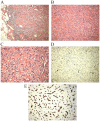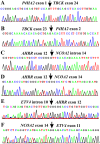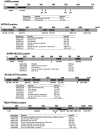Gene fusions AHRR-NCOA2, NCOA2-ETV4, ETV4-AHRR, P4HA2-TBCK, and TBCK-P4HA2 resulting from the translocations t(5;8;17)(p15;q13;q21) and t(4;5)(q24;q31) in a soft tissue angiofibroma
- PMID: 27633981
- PMCID: PMC5055197
- DOI: 10.3892/or.2016.5096
Gene fusions AHRR-NCOA2, NCOA2-ETV4, ETV4-AHRR, P4HA2-TBCK, and TBCK-P4HA2 resulting from the translocations t(5;8;17)(p15;q13;q21) and t(4;5)(q24;q31) in a soft tissue angiofibroma
Abstract
We present an angiofibroma of soft tissue with the karyotype 46,XY,t(4;5)(q24;q31),t(5;8;17)(p15;q13;q21)[8]/46,XY,t(1;14)(p31;q32)[2]/46,XY[3]. RNA‑sequencing showed that the t(4;5)(q24;q31) resulted in recombination of the genes TBCK on 4q24 and P4HA2 on 5q31.1 with generation of an in‑frame TBCK‑P4HA2 and the reciprocal but out‑of‑frame P4HA2‑TBCK fusion transcripts. The putative TBCK‑P4HA2 protein would contain the kinase, the rhodanese‑like domain, and the Tre‑2/Bub2/Cdc16 (TBC) domains of TBCK together with the P4HA2 protein which is a component of the prolyl 4‑hydroxylase. The t(5;8;17)(p15;q13;q21) three‑way chromosomal translocation targeted AHRR (on 5p15), NCOA2 (on 8q13), and ETV4 (on 17q21) generating the in‑frame fusions AHRR‑NCOA2 and NCOA2‑ETV4 as well as an out‑of‑frame ETV4‑AHRR transcript. In the AHRR‑NCOA2 protein, the C‑terminal part of AHRR is replaced by the C‑terminal part of NCOA2 which contains two activation domains. The NCOA2‑ETV4 protein would contain the helix‑loop‑helix, PAS_9 and PAS_11, CITED domains, the SRC‑1 domain of NCOA2 and the ETS DNA‑binding domain of ETV4. No fusion gene corresponding to t(1;14)(p31;q32) was found. Our findings indicate that, in spite of the recurrence of AHRR‑NCOA2 in angiofibroma of soft tissue, additional genetic events (or fusion genes) might be required for the development of this tumor.
Figures




References
-
- Jin Y, Möller E, Nord KH, Mandahl N, Von Steyern FV, Domanski HA, Mariño-Enríquez A, Magnusson L, Nilsson J, Sciot R, et al. Fusion of the AHRR and NCOA2 genes through a recurrent translocation t(5;8)(p15;q13) in soft tissue angiofibroma results in upregulation of aryl hydrocarbon receptor target genes. Genes Chromosomes Cancer. 2012;51:510–520. doi: 10.1002/gcc.21939. - DOI - PubMed
-
- Sugita S, Aoyama T, Kondo K, Keira Y, Ogino J, Nakanishi K, Kaya M, Emori M, Tsukahara T, Nakajima H, et al. Diagnostic utility of NCOA2 fluorescence in situ hybridization and Stat6 immunohistochemistry staining for soft tissue angiofibroma and morphologically similar fibrovascular tumors. Hum Pathol. 2014;45:1588–1596. doi: 10.1016/j.humpath.2013.12.022. - DOI - PubMed
Publication types
MeSH terms
Substances
LinkOut - more resources
Full Text Sources
Other Literature Sources
Miscellaneous

